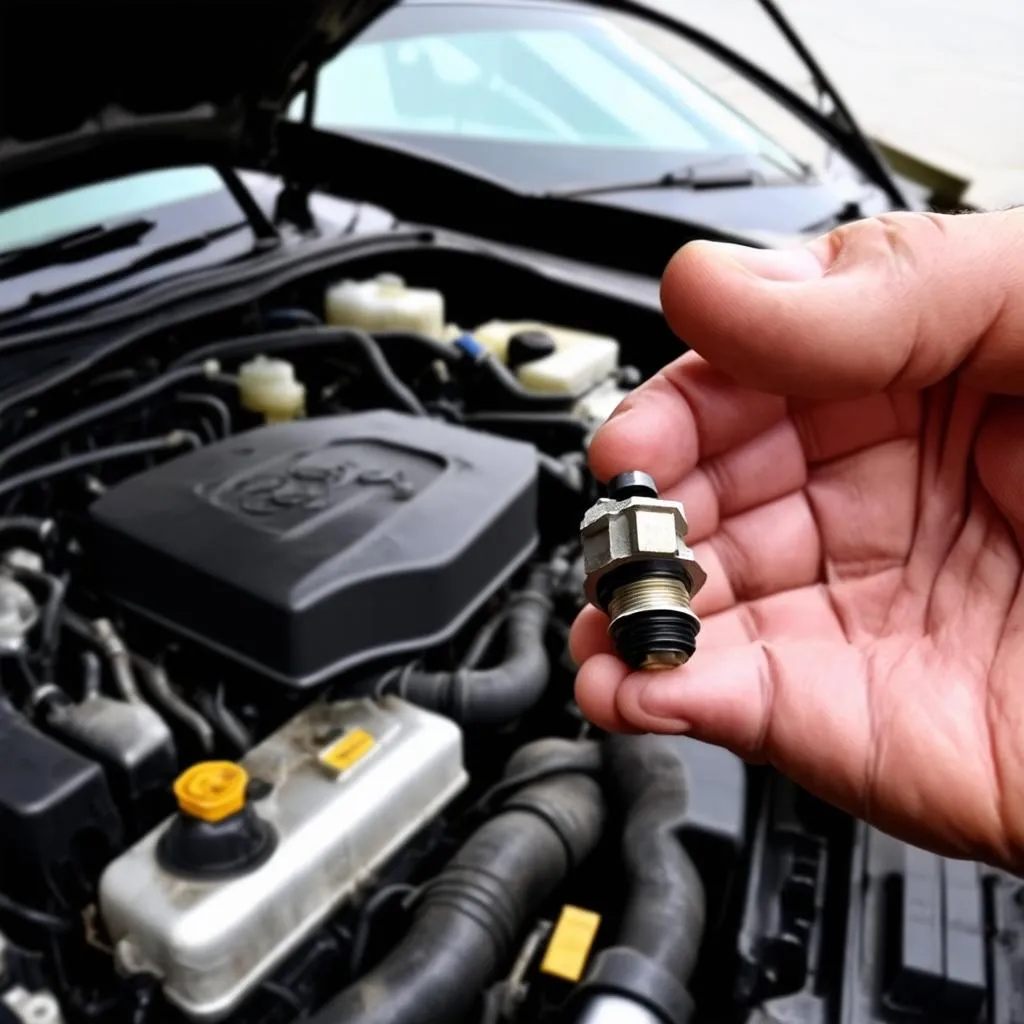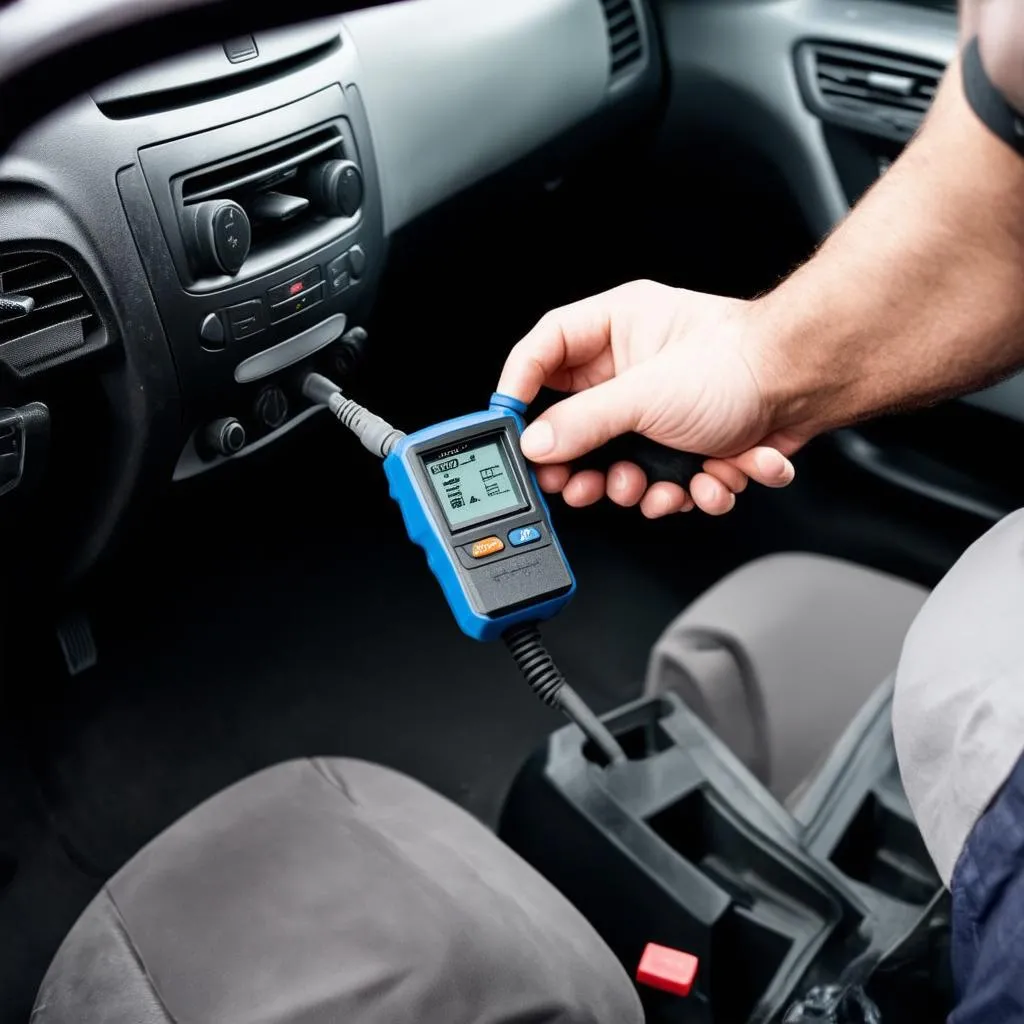Imagine this: you’re cruising down the highway, enjoying the open road, when suddenly, your check engine light throws a wrench into your plans. Frustrating, right? This scenario is all too familiar for many car owners. And more often than not, the culprit behind that pesky light is a mysterious code thrown by your car’s computer, like Obd Code P2195. But what does it mean, and how worried should you be?
Don’t worry; we’re here to break it down! This comprehensive guide delves deep into the world of OBD code P2195, explaining everything you need to know about this common oxygen sensor issue.
What Exactly is Obd Code P2195?
In simple terms, OBD code P2195 indicates that your car’s engine control unit (ECU) has detected a problem with the signal from the oxygen (O2) sensor. Specifically, it means the O2 sensor for bank 1, sensor 1 (located before the catalytic converter on the engine side with the cylinder #1) is sending a signal indicating a too rich condition. This means the air-fuel mixture in your engine’s combustion chamber has too much fuel and not enough oxygen.
Why Should You Care About P2195?
Ignoring this code can lead to:
- Decreased fuel economy: A rich air-fuel mixture forces your engine to work harder, guzzling more gas.
- Damage to your catalytic converter: The catalytic converter works to reduce harmful emissions, but an overly rich mixture can cause it to overheat and fail, leading to a costly repair.
- Reduced engine performance: A poorly optimized air-fuel ratio can lead to sluggish acceleration, rough idling, and even engine stalling.
Common Causes of Obd Code P2195:
While a faulty O2 sensor is a common cause, several other culprits could be triggering the P2195 code:
- Vacuum leak: A leak in the intake manifold or other vacuum hoses can disrupt the air-fuel ratio, causing a rich mixture.
- Faulty fuel injectors: Leaky or clogged fuel injectors can disrupt the fuel supply, leading to a rich condition.
- Malfunctioning fuel pressure regulator: This component maintains the correct fuel pressure; if it fails, it can cause excessive fuel delivery.
- Exhaust leaks: Leaks in the exhaust manifold or pipes near the upstream O2 sensor can introduce outside air, confusing the sensor readings.
Troubleshooting and Fixing P2195:
While a professional mechanic is best equipped to diagnose and fix this issue, there are a few things you can check yourself:
- Visually inspect for vacuum leaks: Look for cracked, loose, or disconnected vacuum hoses.
- Check for exhaust leaks: Listen for any hissing sounds coming from the exhaust manifold or pipes.
Frequently Asked Questions about Obd Code P2195:
Q: Can I still drive my car with a P2195 code?
While you might be able to drive for a short distance, it’s best to address the issue as soon as possible to prevent further damage and avoid costly repairs down the road.
Q: How much does it cost to fix code P2195?
The cost of repair depends on the underlying cause. A simple O2 sensor replacement could cost a couple hundred dollars, while a more complex issue like a faulty fuel injector or catalytic converter replacement could run into the thousands.
Q: Can I use a code reader to clear the P2195 code?
Yes, you can clear the code with a code reader. However, this is only a temporary fix; the code will reappear if the underlying problem is not addressed.
Expert Insights:
As renowned automotive engineer, Dr. Emily Carter, states in her book “The Engine Whisperer,” “Oxygen sensors are vital components in modern vehicles, playing a crucial role in optimizing engine performance and minimizing emissions. Ignoring oxygen sensor related codes like P2195 can have significant consequences for both your wallet and the environment.”
 car oxygen sensor
car oxygen sensor
Related OBD Codes:
P2195 is often associated with other oxygen sensor codes, such as:
- P2196: O2 Sensor Signal Biased/Stuck Rich Bank 1 Sensor 1
- P0130: O2 Sensor Circuit Malfunction (Bank 1 Sensor 1)
Vehicle Makes Commonly Affected by P2195:
While this code can occur in any vehicle with an oxygen sensor, some makes and models seem more prone to it, including certain models from:
- Honda
- Toyota
- Ford
- Chevrolet
- Volkswagen
Need Help with Obd Code P2195?
Dealing with car problems can be overwhelming, but you don’t have to face them alone! Our team of expert automotive technicians is here to help you navigate the complexities of OBD codes and get your car back on the road. We offer:
- 24/7 support: Contact us anytime for expert advice and assistance.
- Remote diagnostics: Save time and money with our remote diagnostic services.
- Personalized solutions: We tailor our solutions to your specific needs and budget.
Don’t let a pesky OBD code ruin your day. Contact us today via WhatsApp at +84767531508 and let us help you get back in the driver’s seat with confidence!
 mechanic using a car diagnostic tool
mechanic using a car diagnostic tool
Keep Exploring:
Looking for more helpful automotive information? Check out these other informative articles on techcarusa.com:
- Understanding Your Car’s Engine Control Unit
- The Importance of Regular Car Maintenance
- Common Car Problems and How to Fix Them
Remember, regular maintenance and addressing issues like OBD code P2195 promptly can save you time, money, and frustration in the long run.
Drive safe and happy motoring!